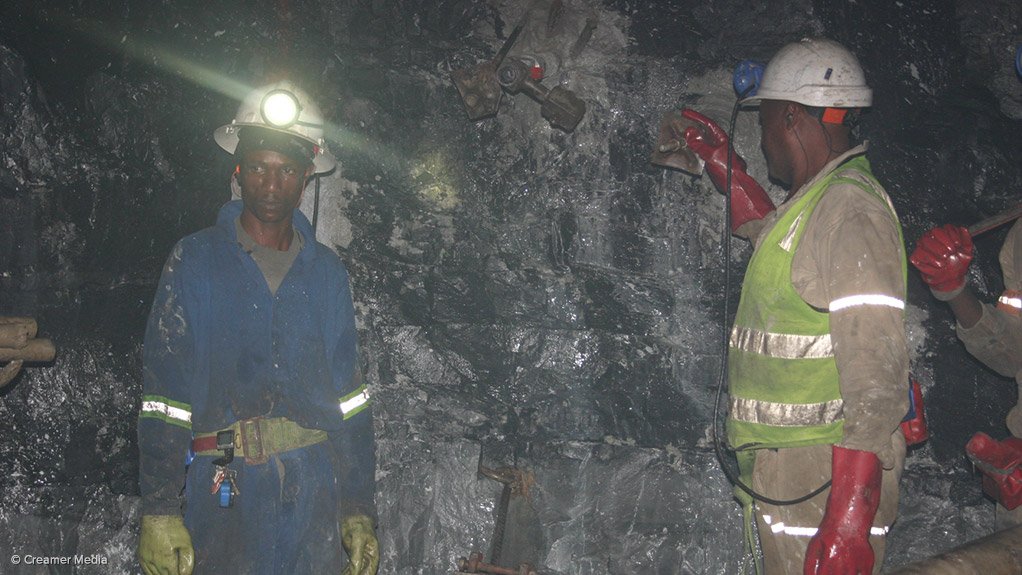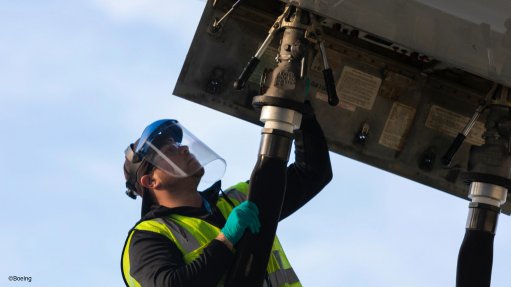Plans afoot to lay off thousands of mineworkers – Baleni



JOBS IN JEOPARDY The gold sector is facing “a bloodbath of job losses”
FRANS BALENI The NUM is negotiating with gold producers to reduce job losses, but believes that, in most instances, the retrenchment numbers will not be significantly reduced
Photo by Duane Daws
National Union of Mineworkers (NUM) general secretary Frans Baleni has said local gold producers Sibanye Gold, AngloGold Ashanti and Harmony Gold are undertaking retrenchments at their respective operations across South Africa.
“Some of these companies have started offering miners voluntary lay-off packages, while others have initiated the Section 189A consultation process on job losses [which are required under the provisions of the Labour Relations Act] with employees,” he tells Mining Weekly.
Baleni laments that even prior to the start of the union’s collective bargaining conference for the gold sector in Johannesburg next month, “the gold sector is facing a bloodbath of job losses”.
While the bullion producers have been tight-lipped about exactly how many employees are facing retrenchment, Baleni says that, according to his information, AngloGold Ashanti plans to reduce its workforce by 6 000, Harmony by about 3 400 and Sibanye by about 2 500.
He points out that the NUM is in discussions with Harmony specifically about its Kusasalethu mine, where 1 400 of the 6 300 mineworkers face possible retrenchment.
Harmony corporate and investor relations executive Marian van der Walt says that the company’s plan to return the lossmaking Kusasalethu to profitability is being discussed with the unions represented at the mine.
However, she adds, the Section 189 consultation process is ongoing and “it is too soon to say how many people will be affected”.
AngloGold Ashanti spokesperson Chris Nthite states “categorically” that the 6 000 figure mentioned by Baleni has never been part of any discussion with organised labour.
“As we have said at our results presentation in November 2014, we are in the process of consolidating our footprint in South Africa from five mines and two surface operations into three entities to capture operating, service and infrastructural synergies of these neighbouring units.
“Currently, we do have a voluntary severance programme to reduce employee numbers in certain areas. This process is ongoing and continues to deliver positive outcomes based on mutual agreement. We remain in discussions with staff and organised labour as this programme continues,” he emphasises.
Additionally, Sibanye Gold CEO Neal Froneman confirms to Mining Weekly that the company is currently concluding a Section 189 process at its Cooke 4 underground operation on the West Rand, owing to the lossmaking status of the shaft.
“If shaft closure had become necessary, it is correct that up to 2 500 jobs could have been affected,” he states.
However, Froneman highlights that, through cooperation with stakeholders at the shaft, a turnaround programme has been constructed and is currently being implemented, which has “saved the vast majority of the jobs that could have been lost through shaft closure”.
“Sibanye currently has no further plans for retrenchment of employees,” he affirms.
Baleni, however, emphasises that tbe NUM is “extremely concerned” about these numbers, in terms of not only job losses but also their impact on the economy, mineworkers and their dependants.
“We are negotiating with these gold producers to reduce job losses, but, in most instances, the retrenchment numbers will not be significantly reduced. I also cannot say at this stage whether. . . we will embark on strike action, owing to these possible large-scale retrenchments.”
However, Baleni highlights that the labour union convinced Sibanye to reverse its decision in June 2013 to close Beatrix West Section in Welkom, in the Free State. Subsequently, this has resulted in the mine returning to profitability and potential job losses being averted. He adds that this is a clear indication that labour unions can protect the rights of their members while assisting mines in improving their operational efficiencies.
“It is important that negotiations between unions and mining houses be in good faith, as often we are of the view that companies are not willing to make even minimal changes to decisions pertaining to retrenchment numbers.”
Froneman says Sibanye acknowledges the constructive engagement with stakeholders, which took place at the Beatrix West operation through a Section 189 consultation process conducted early in 2013.
“This process enabled a successful turnaround to be implemented with minimal job losses, and Beatrix West has secured a viable future following a decade of breakeven or lossmaking operations. The outcome highlights the importance of the Section 189 consultation process,” he notes
However, Froneman says that it is somewhat “mischievous” for the NUM to suggest that it convinced management to change its decision.
He adds that, in the cases of Cooke 4 and Beatrix West, Sibanye wishes to place on record that no decisions had ever been made to close these operations.
“That would not have been possible until all avenues had been exhausted to avoid job losses through the Section 189 consultation process. Sibanye remains committed to constructive engagement with all stakeholders through the applicable legal processes to secure a prosperous gold mining sector in South Africa that creates superior value for all our stakeholders,” Froneman emphasises.
Further, Baleni notes that a major challenge that the union faces is “the level of gullibility of workers” who “wholeheartedly” believe unions that promise, for example, to deliver increased wages of 300% to workers.
He adds that rumours are circulating among mineworkers that a rival union – alluding specifically to the Association of Mineworkers and Construction Union – is touting R16 000 as the basic wage for mineworkers in the sector.
“It is highly challenging for us to engage with some workers about reasonable wage demands while they are excited by such sensationalist amounts at the expense of logic and reason,” he says.
Meanwhile, Baleni points out that, when the gold price was at it lowest, about $280/oz, between 1999 and 2001, the NUM settled on wage increases, which were 4% below inflation, but the mines compensated workers in other ways by improving mine accommodation, issuing shares to mineworkers and eventually increasing salaries as the gold price increased.
“There was a give-and-take-type atmosphere, which ensured that workers and companies could overcome that challenging period.”
Additionally, he notes that, in 2009, employees of gold producer Village Main Reef’s Blyvoor–uitzicht mine, in Gauteng, informed the NUM – seeking to secure wage increases of about 10% at the time – that if such a double-digit increase were to be implemented across the gold sector, the mine would have to close. Therefore, workers agreed with the NUM that the mine would be exempt from the 10% increase demand. “Mineworkers told the NUM that they had been fully briefed about the ailing plight of the mines’ operations and that the mine was able to continue operations until August 2013, when it closed down.” He highlights that these examples illustrate that where transparency and pragmatism between workers and mining companies exist, solutions can be reached for the benefit of all. “However, the major challenge that we face is the deficit of trust between the NUM and the management of gold mining companies, which must be overcome if we are to avoid the chaos that played out in the platinum sector over the past five years in the gold sector,” Baleni warns.
Comments
Announcements
What's On
Subscribe to improve your user experience...
Option 1 (equivalent of R125 a month):
Receive a weekly copy of Creamer Media's Engineering News & Mining Weekly magazine
(print copy for those in South Africa and e-magazine for those outside of South Africa)
Receive daily email newsletters
Access to full search results
Access archive of magazine back copies
Access to Projects in Progress
Access to ONE Research Report of your choice in PDF format
Option 2 (equivalent of R375 a month):
All benefits from Option 1
PLUS
Access to Creamer Media's Research Channel Africa for ALL Research Reports, in PDF format, on various industrial and mining sectors
including Electricity; Water; Energy Transition; Hydrogen; Roads, Rail and Ports; Coal; Gold; Platinum; Battery Metals; etc.
Already a subscriber?
Forgotten your password?
Receive weekly copy of Creamer Media's Engineering News & Mining Weekly magazine (print copy for those in South Africa and e-magazine for those outside of South Africa)
➕
Recieve daily email newsletters
➕
Access to full search results
➕
Access archive of magazine back copies
➕
Access to Projects in Progress
➕
Access to ONE Research Report of your choice in PDF format
RESEARCH CHANNEL AFRICA
R4500 (equivalent of R375 a month)
SUBSCRIBEAll benefits from Option 1
➕
Access to Creamer Media's Research Channel Africa for ALL Research Reports on various industrial and mining sectors, in PDF format, including on:
Electricity
➕
Water
➕
Energy Transition
➕
Hydrogen
➕
Roads, Rail and Ports
➕
Coal
➕
Gold
➕
Platinum
➕
Battery Metals
➕
etc.
Receive all benefits from Option 1 or Option 2 delivered to numerous people at your company
➕
Multiple User names and Passwords for simultaneous log-ins
➕
Intranet integration access to all in your organisation




















